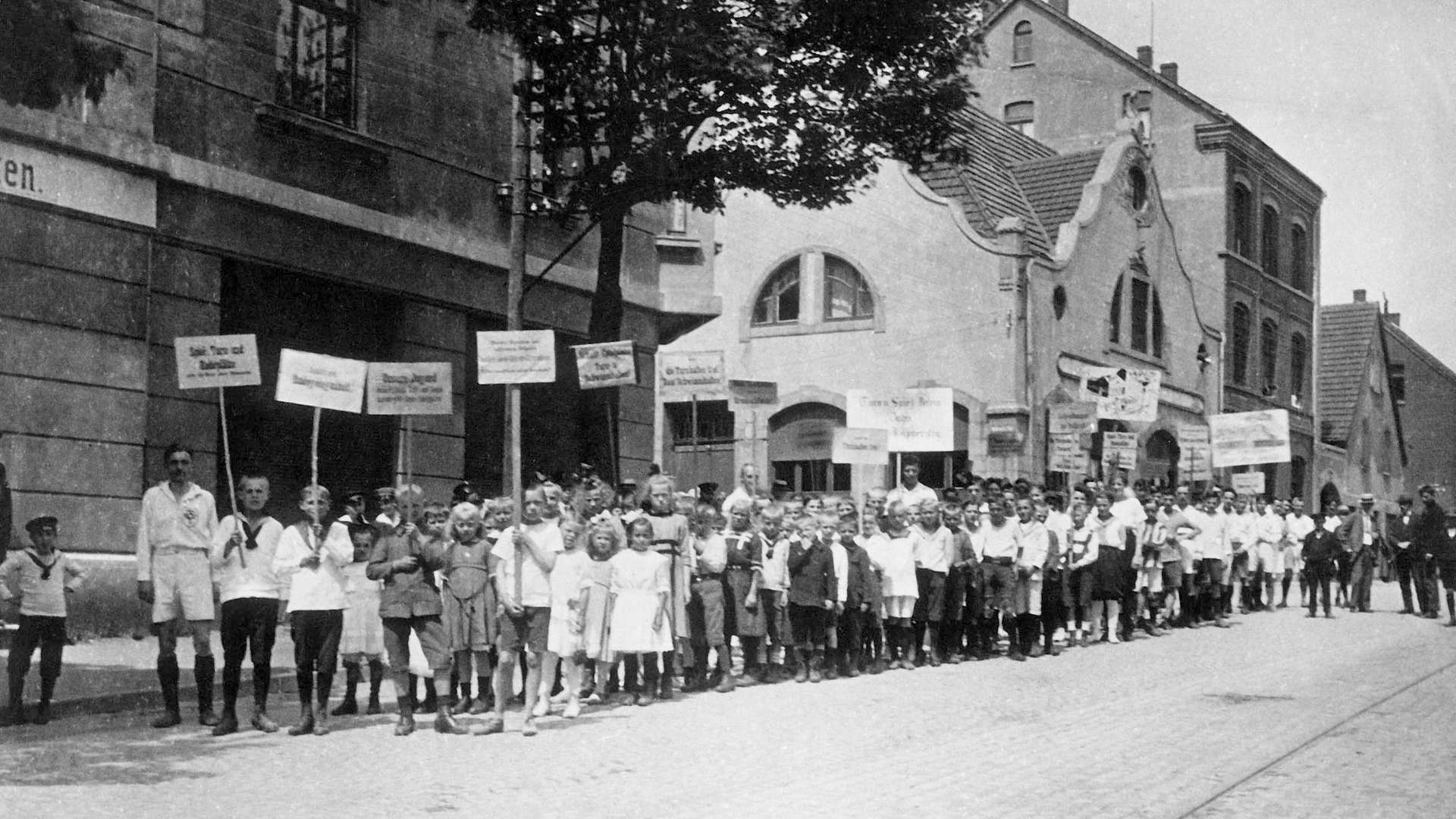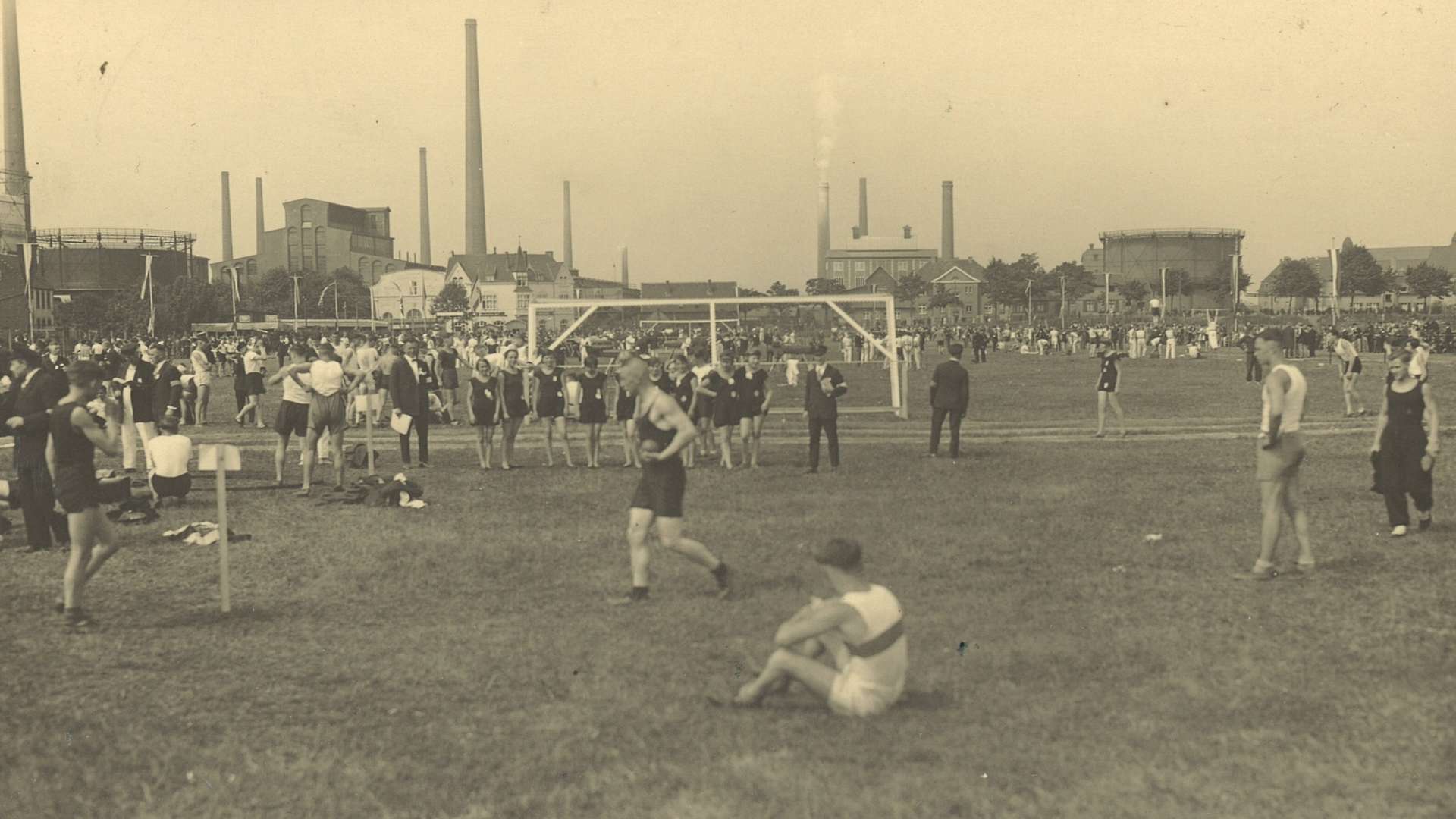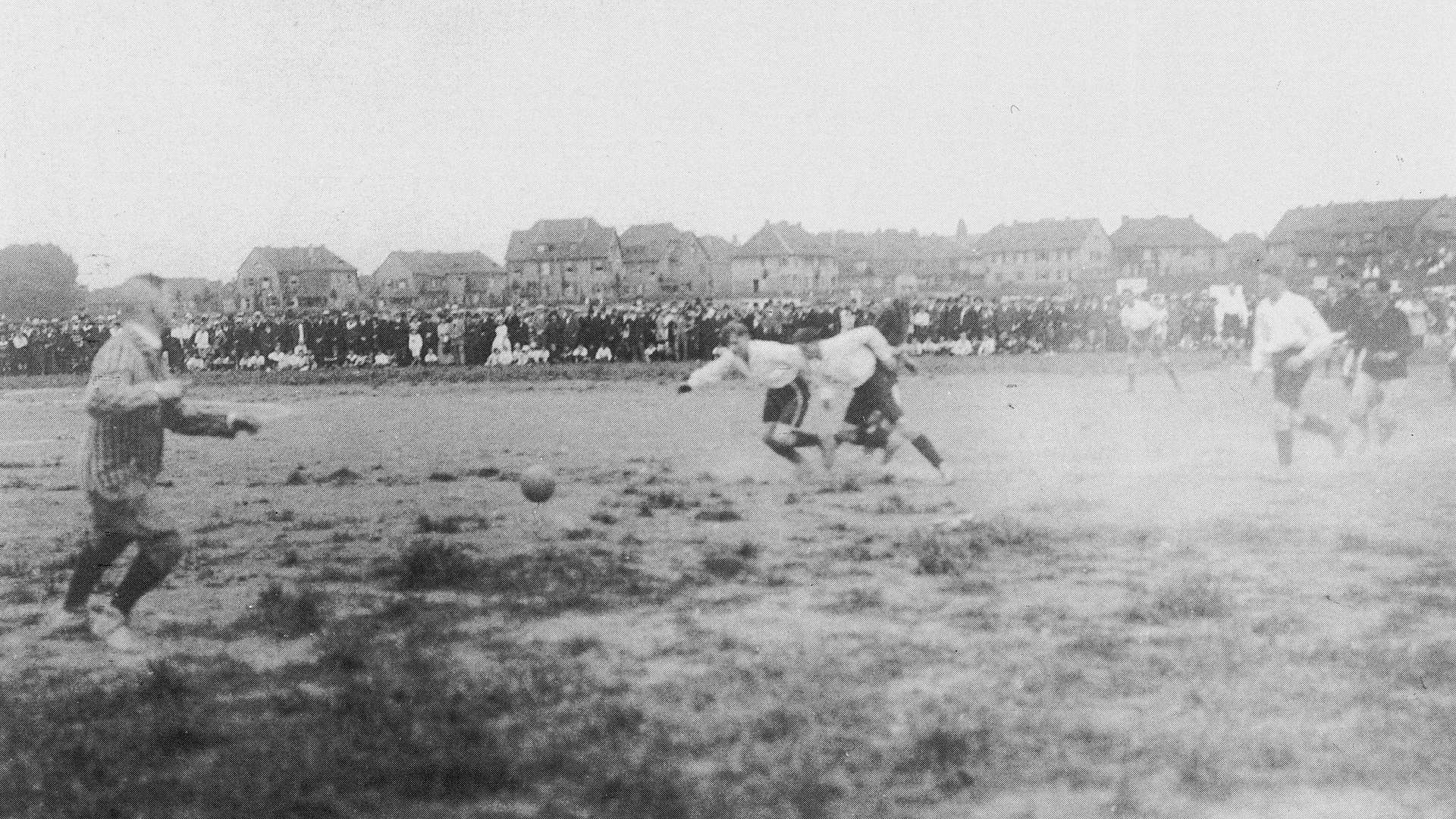1920s
On 13 June 1920 Greater Wiesdorf, that is Wiesdorf including the so-called works settlement Leverkusen on Kaiser Wilhelm Allee, Bürrig and Manfort put on a large-scale sports ground campaign day. The gymnastics clubs of the three communities used this rally to point out the lack of opportunities to play sport through chants and placards. It was not just about sports grounds as there was also a lack of gymnasiums and a public bath on the Rhine (there was one in the works). A march supported by all the gymnastics clubs saw all the participants meet up for a large rally on the market square including a lot of children dressed completely in white. Afterwards there was a sports event on the Ground on the Dhünn. Several thousand spectators ringed the pitch.

A group sets off from Hardenbergstraße in Küppersteg to the market square in Wiesdorf.
As a result of this event, an old brick works pit opposite the Wiesdorfer Hof - today's vehicle centre of the CHEMPARK between Willy Brandt Ring and the big furniture store on Ludwig Erhard Square - is turned into a sports ground by the paint factories, called the DT Ground, and the planned demolition of the Wiesdorfer Hof and the adjoining Germaniasaal (today the corner of TitanStraße and Friedrich Ebert Straße) is postponed indefinitely. That indefinite period stretches until after the Second World War. The Germaniasaal is now used a lot by all departments as a sports hall. The football team, still wearing the black and white kit of TuS 04, play in the lower climes of the ninth division in Cologne.

DT Ground in 1929. The white building in the background is the Wiesdorfer Hof with the Germaniasaal.
In 1923 there is a Germany-wide 'clean breach' between gymnastics and 'sport'. The gymnasts want to return to the father of gymnastics Jahn, that is gymnastics not only included the high and parallel bars but also fencing, swimming and ball games such as fistball but not games on grass from abroad. The footballers take a different point of view and above all want competitive sport with other teams. That leads to separation individual sections in many clubs in Germany. At TuS 04 the football section separates from the whole club and forms its own club: the 'Football club 04 Leverkusen', in short FV 04 Leverkusen with club colours of red and black.
The first outstanding personality amongst the footballers emerged during this decade: Richard Bartsch. Captain for many years, successful goalscorer and playmaker qualities were a mix of pace, shooting ability and outstanding ball control. He was also physically superior to his opponents and was considered to be a 'football giant'.
The Dhünn Ground was unfortunately often subject to flooding so that the footballers had to find new venues again and again. The thick clumps of grass that surrounded the foot marks in the centre of the clay and ash pitch often shot up so that the footballers not only had to get round their opponents but also the often more arduous clumps of grass.

The preferred alternative venue is a sports ground on the former brick works north of Manforter Straße, the former home of BV Wiesdorf, a stone's throw from the DT Ground of TuS 04. Today that is the site of the German Pension Insurance building. From 1927 there is another alternative venue. The Manforter Stadium west of Kalkstraße is officially opened on 12 June 1927 and it is occasionally used for training sessions and matches for the football team up until after the war.

The football team of FV 04 Leverkusen included players in their ranks who liked to throw the ball but unfortunately there are not enough players available for competitive matches. Outdoor handball becomes more and more popular from 1927. And the boxers of Boxsport Wiesdorf include men who indulge in the handball game as a counterbalance on the BV Wiesdorf pitch in the evening – also in insufficient numbers. That leads to the sportsman coming together and through the love of the game combining to form FV 04 Leverkusen/Boxsport Wiesdorf for friendly fixtures. Both the footballers and the boxers at put in a lot of work in their clubs before the merger comes about. 1928 sees the founding of the ' Sportvereinigung Wiesdorf-Leverkusen 04' with football, boxing, outdoor handball, athletics and fistball sections. The second big club in addition to TuS is formed. The club colours remain red and black.
At the same time as the merger, a young playmaker and centre forward steps into the limelight: Peter 'Fitti' Schmitz, a splendid technician and a battler to boot. Whenever he takes a breather you can hear the voice of Papa Schmitz loud and clear throughout the ground as he encourages his offspring to carry on. He is at the heart of the Bayer game 19 years.
The General Anzeiger writes on 28 January 1929: "In front of a large crowd, the home club were able to show off their new kit: orange shirts, blue shorts and orange socks." That was the colour combination worn by Sp. Vg. Wiesdorf-Leverkusen for the next two and half years - with change colours of blue shirts, orange shorts and socks. The club finally makes the jump into the third highest league in Germany, the first district league. But that only happens in the 1930s.
Sources:
- Walter Scharf – '50 Jahre Bayer 04 – Die Geschichte eines Sportvereins'
- '50 Jahre Turn- und Spielverein 1904 EV der Farbenfabriken Bayer Leverkusen'
- Matthias Bauschen – '100 Jahre Bayer 04 – Die Geschichte eines einzigartigen Sportvereins'
- Werner Röhrig – Gesammelte Zeitungsausschnitte aus 100 Jahren Bayer 04 Leverkusen (Bayer 04 archive)
- Leverkusen municipal archive
